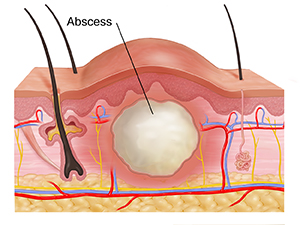Abscess Drainage
An abscess is a pocket of pus that forms around an infection. Pus is a fluid made up of germs (bacteria), white blood cells, and other matter. Draining pus from an infected area or organ inside the body may be needed. This helps heal the infection. The procedure is usually done by a specially trained doctor called an interventional radiologist.

How do I get ready for abscess drainage?
Follow any instructions you are given on how to prepare, including:
-
Don't eat or drink anything for 6 hours before the procedure.
-
Tell the technologist if you are, or could be, pregnant or if you are breastfeeding.
-
Tell your healthcare provider and the technologist if you are allergic to X-ray dye (contrast medium) or other medicines.
-
Be sure your healthcare provider knows about any health conditions you have and all medicines you take. You may be told to stop taking some or all of them before the test. This includes:
-
All prescription medicines
-
Over-the-counter medicines that don’t need a prescription
-
Any illegal drugs you may use
-
Herbs, vitamins, kelp, seaweed, cough syrups, and any other supplements
What happens during abscess drainage?
-
You will change into a hospital gown and lie on an X-ray table. You may lie on your back, front, or side, depending on the site of the abscess.
-
An IV (intravenous) line is put into your vein to give you fluids and medicines. You may be given medicine through the IV to help you relax.
-
The skin over the abscess is cleaned. A local anesthetic is applied to numb the skin.
-
Using a CT scan or ultrasound images as a guide, the radiologist puts a needle through the skin and guides it to the abscess. The needle is then replaced with a thin, flexible tube (catheter).
-
Pus drains from the abscess through the catheter. A bag or suction bulb will be attached to the catheter to hold the pus as it drains.
-
The drainage catheter will be temporarily sutured or taped to your skin to help secure it and prevent it from moving.
-
The entire procedure may take 30 minutes or longer, depending on the location of the abscess.
What happens after abscess drainage?
-
A slight fever is normal for the first 24 hours after the procedure.
-
The catheter and drainage bag will likely remain in place for several days. Follow any instructions you are given for caring for the catheter and drainage site.
-
See your healthcare provider for a follow-up appointment to check the infection and to have the catheter removed.
When to call your healthcare provider
Call your healthcare provider if you have:
-
Bleeding
-
Fever of 100.4°F (38°C) or higher, or as directed by your healthcare provider
-
Chills
-
New or worsening pain
-
Fluid stops draining from the tube, the drainage changes color, or the tube moves or comes out
Online Medical Reviewer:
Jessica Gotwals RN BSN MPH
Online Medical Reviewer:
Neil Grossman MD
Online Medical Reviewer:
Raymond Turley Jr PA-C
Date Last Reviewed:
10/1/2022
© 2000-2025 The StayWell Company, LLC. All rights reserved. This information is not intended as a substitute for professional medical care. Always follow your healthcare professional's instructions.